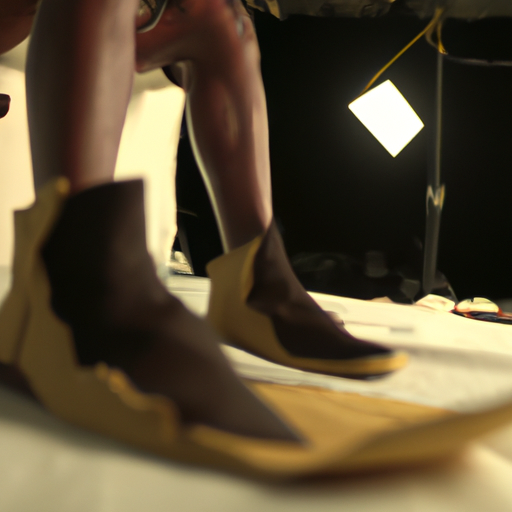Table of Contents
- Introduction
- How Fashion Designers are Adapting to the Changing Landscape of the Fashion Industry
- The Role of Resilience in the Success of Fashion Designers
- How to Overcome Challenges and Rebuild Your Fashion Design Career
- The Benefits of Embracing Change and Innovation in Fashion Design
- How to Develop a Resilient Mindset as a Fashion Designer
- The Power of Collaboration and Networking for Fashion Designers
- Strategies for Building Resilience and Overcoming Setbacks in the Fashion Industry
- Conclusion
«Fashion designers: Creating beauty through resilience.»
Introduction
Fashion designers are some of the most resilient people in the world. They have to constantly stay on top of trends, create new designs, and keep up with the ever-changing fashion industry. Despite the challenges, fashion designers have managed to stay creative and innovative, adapting to the changing times and creating beautiful pieces of clothing that have become iconic. From Coco Chanel to Alexander McQueen, fashion designers have shown that they can overcome any obstacle and continue to create timeless pieces of art. This article will explore the resilience of fashion designers and how they have managed to stay relevant in the ever-changing fashion industry.
How Fashion Designers are Adapting to the Changing Landscape of the Fashion Industry
The fashion industry is constantly evolving, and fashion designers must be able to adapt to the changing landscape in order to remain competitive. In recent years, the industry has seen a shift towards digitalization, sustainability, and ethical production. As a result, fashion designers must be able to adjust their strategies and processes to meet these new demands.
One of the most significant changes in the fashion industry is the move towards digitalization. Many fashion designers are now using digital tools to create their designs, such as 3D printing and computer-aided design (CAD) software. This allows them to create more complex and detailed designs, as well as to quickly and easily make changes to existing designs. Additionally, digital tools can be used to create virtual fashion shows, which can be shared with customers and potential buyers.
Sustainability is also becoming increasingly important in the fashion industry. Many fashion designers are now using sustainable materials, such as organic cotton and recycled fabrics, in their designs. Additionally, they are looking for ways to reduce their environmental impact, such as using renewable energy sources and reducing water consumption.
Finally, ethical production is becoming increasingly important in the fashion industry. Many fashion designers are now looking for ways to ensure that their production processes are ethical and that their workers are treated fairly. This includes ensuring that workers are paid a living wage and that they are provided with safe working conditions.
Overall, fashion designers must be able to adapt to the changing landscape of the fashion industry in order to remain competitive. By embracing digitalization, sustainability, and ethical production, fashion designers can ensure that their designs are up-to-date and that their production processes are ethical.
The Role of Resilience in the Success of Fashion Designers
The fashion industry is a highly competitive and ever-changing field, and fashion designers must possess a unique combination of creativity, technical skill, and resilience in order to succeed. Resilience is an essential quality for fashion designers, as it allows them to remain focused and motivated in the face of adversity.
Resilience is the ability to bounce back from difficult situations and to remain positive and motivated despite setbacks. It is a key factor in the success of fashion designers, as it allows them to remain focused on their goals and to continue to create innovative designs despite any obstacles they may face. Resilience also helps fashion designers to stay motivated and to keep pushing themselves to reach their goals.
Fashion designers must be able to handle criticism and rejection, as well as the pressure of meeting deadlines and staying on top of trends. Resilience helps fashion designers to stay focused on their goals and to remain motivated despite any setbacks they may face. It also helps them to remain creative and to continue to develop innovative designs.
Resilience also helps fashion designers to stay organized and to manage their time effectively. This is important, as fashion designers must be able to juggle multiple tasks and projects at once. Resilience helps them to stay focused and to remain productive despite any obstacles they may face.
Finally, resilience helps fashion designers to stay confident in their abilities and to remain positive despite any challenges they may face. This is important, as fashion designers must be able to take risks and to trust their instincts in order to create successful designs.
In conclusion, resilience is an essential quality for fashion designers, as it allows them to remain focused and motivated in the face of adversity. It helps them to stay organized, to manage their time effectively, and to remain creative and confident in their abilities. Resilience is a key factor in the success of fashion designers, and it is an essential quality for anyone looking to succeed in the fashion industry.
How to Overcome Challenges and Rebuild Your Fashion Design Career
The fashion design industry is a highly competitive and ever-changing field. As a fashion designer, you may face many challenges that can make it difficult to stay on top of the latest trends and build a successful career. However, with the right strategies and mindset, you can overcome these challenges and rebuild your fashion design career.
First, it is important to stay up to date with the latest trends in the fashion industry. This means researching the latest styles, fabrics, and colors, as well as keeping an eye on what other designers are doing. Additionally, attending fashion shows and networking with other designers can help you stay informed and inspired.
Second, it is essential to stay organized and manage your time effectively. This means creating a schedule and sticking to it, as well as setting realistic goals and deadlines. Additionally, it is important to prioritize tasks and focus on the most important ones first.
Third, it is important to stay motivated and focused on your goals. This means setting aside time to reflect on your progress and celebrate your successes. Additionally, it is important to take breaks and find ways to relax and recharge.
Finally, it is important to stay positive and resilient. This means focusing on the present and not dwelling on past mistakes. Additionally, it is important to be open to feedback and criticism, as this can help you grow and improve.
By following these strategies, you can overcome the challenges of the fashion design industry and rebuild your career. With the right mindset and dedication, you can create a successful and fulfilling career in fashion design.
The Benefits of Embracing Change and Innovation in Fashion Design

Change and innovation are essential components of fashion design. By embracing change and innovation, fashion designers can create unique and exciting designs that stand out from the competition. This article will discuss the benefits of embracing change and innovation in fashion design.
First, embracing change and innovation allows fashion designers to stay ahead of the curve. By staying ahead of the trends, fashion designers can create designs that are unique and eye-catching. This can help them to stand out from the competition and attract more customers. Additionally, embracing change and innovation can help fashion designers to stay relevant in the ever-changing fashion industry. By staying up-to-date with the latest trends, fashion designers can ensure that their designs remain fashionable and attractive to customers.
Second, embracing change and innovation can help fashion designers to create more sustainable designs. By using innovative materials and techniques, fashion designers can create designs that are more eco-friendly and sustainable. This can help to reduce the environmental impact of fashion production and ensure that fashion designers are doing their part to protect the planet.
Finally, embracing change and innovation can help fashion designers to create designs that are more comfortable and practical. By using innovative materials and techniques, fashion designers can create designs that are more comfortable and practical for everyday wear. This can help to ensure that customers are satisfied with their purchases and that they will continue to purchase from the fashion designer in the future.
In conclusion, embracing change and innovation in fashion design can be beneficial for fashion designers in many ways. By staying ahead of the trends, creating more sustainable designs, and creating more comfortable and practical designs, fashion designers can ensure that their designs remain fashionable and attractive to customers.
How to Develop a Resilient Mindset as a Fashion Designer
As a fashion designer, developing a resilient mindset is essential for success. Resilience is the ability to cope with and adapt to difficult situations, and it is a key factor in achieving success in the fashion industry. Here are some tips for developing a resilient mindset as a fashion designer:
1. Develop a Positive Attitude: Having a positive attitude is essential for developing resilience. A positive attitude will help you stay motivated and focused on your goals, even when faced with challenges.
2. Set Realistic Goals: Setting realistic goals is important for staying motivated and achieving success. Make sure your goals are achievable and that you have a plan for how to reach them.
3. Learn from Mistakes: Mistakes are inevitable, but they can be used as learning opportunities. Instead of dwelling on mistakes, use them as a chance to learn and grow.
4. Stay Connected: Building a strong network of peers and mentors is essential for staying resilient. Having a support system of people who understand the fashion industry can help you stay motivated and focused on your goals.
5. Take Care of Yourself: Taking care of your physical and mental health is essential for staying resilient. Make sure to take time for yourself and practice self-care.
By following these tips, you can develop a resilient mindset as a fashion designer. With a resilient mindset, you will be better equipped to handle the challenges of the fashion industry and achieve success.
The Power of Collaboration and Networking for Fashion Designers
Fashion designers are creative professionals who are constantly looking for new ways to express their ideas and create unique designs. As such, collaboration and networking are essential tools for fashion designers to stay ahead of the competition and stay connected with the industry.
Collaboration is a key factor in the success of any fashion designer. Working with other designers, manufacturers, and retailers can help fashion designers to create innovative designs and gain access to new resources. Collaboration also allows fashion designers to share ideas and learn from each other, which can lead to new and exciting designs.
Networking is also an important part of a fashion designer’s success. By connecting with other fashion professionals, designers can gain access to new resources, learn about upcoming trends, and stay up-to-date on the latest industry news. Networking also allows fashion designers to build relationships with potential clients and partners, which can lead to new opportunities.
The power of collaboration and networking for fashion designers cannot be overstated. By working together and connecting with other professionals, fashion designers can create innovative designs, gain access to new resources, and stay ahead of the competition. Collaboration and networking are essential tools for any fashion designer who wants to succeed in the industry.
Strategies for Building Resilience and Overcoming Setbacks in the Fashion Industry
The fashion industry is a highly competitive and ever-changing field, and it can be difficult to stay afloat in the face of setbacks. However, resilience is key to success in this industry, and there are several strategies that can help fashion professionals build resilience and overcome setbacks.
1. Develop a Growth Mindset: A growth mindset is the belief that one’s abilities and skills can be developed through effort and dedication. This mindset is essential for success in the fashion industry, as it allows professionals to view setbacks as opportunities for growth and development.
2. Stay Positive: It can be easy to become overwhelmed by setbacks, but it is important to stay positive and focus on the future. Keeping a positive attitude can help fashion professionals stay motivated and focused on their goals.
3. Network: Networking is an important part of the fashion industry, and it can be a great way to build resilience and overcome setbacks. By connecting with other professionals in the industry, fashion professionals can gain valuable insight and advice that can help them stay on track.
4. Take Time to Reflect: Taking time to reflect on setbacks can help fashion professionals gain perspective and develop strategies for overcoming them. Reflecting on the situation can also help professionals identify areas for improvement and develop a plan for moving forward.
5. Seek Support: Seeking support from family, friends, and colleagues can be a great way to build resilience and overcome setbacks. Having a support system can provide emotional and practical support, which can be invaluable in times of difficulty.
By following these strategies, fashion professionals can build resilience and overcome setbacks in the fashion industry. With dedication and hard work, fashion professionals can stay on track and achieve success in this competitive field.
Conclusion
Fashion designers have proven to be resilient in the face of adversity. Despite the challenges posed by the pandemic, they have adapted to the changing landscape and found creative ways to stay afloat. They have embraced digital technology, embraced new business models, and found innovative ways to reach their customers. As the fashion industry continues to evolve, fashion designers will continue to demonstrate their resilience and creativity.


































